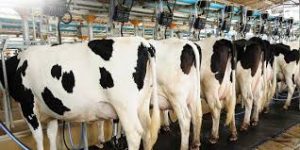Animal Husbandry of Rajasthan
- In Rajasthan, animal husbandry is not merely a subsidiary to agriculture but it is a major economic activity, especially in arid and semi-arid areas, thus providing the much needed insurance against frequently occurring scarcity conditions. Parallel to crop production, animal husbandry is the most important activity in Rajasthan. Livestock rearing is the major component of arid agriculture. Animal husbandry enhances the economic viability and sustainability of farming systems particularly in rain fed areas. In arid western region, livestock farming essentially works as an insulating factor against vagaries of drought and famines, and provides a kind of stability and sustainable livelihood to the rural poor.
- The State is endowed with finest drought hardy milch breeds (Rathi, Gir, Sahiwal and Tharparkar), dual purpose breeds (Kankrej and Haryana) and the famous drafts breeds of Nagori and Malvi. The State of Rajasthan is rich in livestock wealth. State is blessed with the best breeds of cattle, sheep and camels of the country.
Some Breeds of Animals in Rajasthan
| Cow | Rathi (Kamdhenu of Rajasthan), Gir, Tharparkar, Kankrez |
| Buffalo | Murra (Khundi), Jafravadi, Badavari, |
| Goat | Marwadi (Highest), Shekhawati, Jhakhrana (Alwari) |
| Sheep | Chokla (Marino of Inida), Nali, Jaisalmeri, Sonadi |
| Camel | Bikaneri (Highest), Nachana, Bikaneri |
| Horse | Kathiawadi, Marwadi, Malani (superior breed) |
- The livestock Census-2012 has placed total livestock population at 577.32 lakh and poultry birds at 80.24 lakh. The State has about 11.27 per cent of the livestock of the country. The State accounts for about 6.89 per cent of cattle, 11.94 per cent of buffaloes, 16.03 per cent of goats, 13.95 per cent of sheep and 81.31 per cent of camels of the country. The State contributes 11.90 per cent of milk and 30.78 per cent of wool to the nation’s production in the year 2015-16.Efforts of the Animal Husbandry Department are focused on increasing the out stretch through creation of institutions and infrastructure to provide an integrated package of services for efficient health care and genetic improvement of livestock along with awareness building programmes to ensure better participation of the livestock owners, expansion of veterinary institutions in the State has been quite remarkable.
As per the 19th livestock census of 2012 :-
- There are 32lacs animals(which include Cattle, buffalo, Sheep, Goat, Horse & Ponies, Mules, Donkeys, Camel, Pig) and over 80.24lacs Poultry in the State.
- Rajasthan has about only 7% of the country’s cattle population and contributes about 11% of the total milk production, 30% of the mutton and 31% wool produced in the country. Rajasthan is first in Wool production while Second in milk production.
- As a % of total livestock population Goat has highest 37 % and camel is decreasing and among the lowest for last 10 years.
- Total livestock census 57732204; Barmer has highest 5366732
and in Livestock density per sq km, Dausa and Rajasmand have 192 (Highest)
- Sheep and camel has the highest negative % change While horses and mules and highest positive % change in last 10 years.
Major initiatives taken by the Animal Husbandry Department during the year 2016-17:
- Bhamashah Livestock Insurance policy has been launched in the State to protect farmers and livestock owners from the loss caused by the untimely death of livestock. According to the scheme, livestock owners under SC/ST and BPL category will be granted 70 per cent rebate of the premium and rest will be granted 50 per cent of the premium.
- Through livestock owners honoring ceremony sanctioned under RKVY, an incentive amount of 50,000 each for two livestock owners including one women were rewarded at state level, 68 livestock owners including 12 women were rewarded with an amount of `25,000 each at district level and 243 livestock owners including 37 women were rewarded with an amount of `10,000 each at panchayat samiti level. A total amount of `30 lakh has been awarded to 313 progressive livestock owners of the State.
- A total amount of `80 lakh has been awarded to 348 progressive women livestock owners selected at the state/district/panchayat samiti level during women livestock owners honouring ceremony. Foot and Mouth Disease control programme is initiated in the State with the assistance of GoI with the aim to control and contain Foot and Mouth Disease. Under the programme 130 lakh animals have been vaccinated upto December,2016.
- Camel breeding incentive scheme has been launched on 2nd October, 2016 in order to curb the constantly falling number of camels and to encourage camel breeding in the State.Poultry and quail farming development scheme has been launched in 23 districts of the State under RKVY.
- During Global Rajasthan Agritech Meet (GRAM) 2016, Animal Husbandry Department exhibited different activities like superior livestock asset of the State, “Low input technology poultry and pilot quail farming development scheme” etc.
GOPALAN DEPARTMENT
- The aim of the Directorate of Gopalan is to act rigorously for promotion, conservation programmes and development of the cattle population of the State including cattle reared in gaushalas of the State by means of various training programmes for imparting managerial skills to gaushala managers in the fields of organic farming and fodder production, marketing of cattle products, renewable energy use of Panchgavya and value addition etc.
- During the year 2016-17, budget of `86 crore has been allotted to 20 district collectors for the cattle saved from slaughter. Assistance is being given at the rate of `32 per large cattle head and `16 per small cattle head for the period of detention of the cattle in gaushalas or for one year whichever is less. Under RKVY scheme, Agriculture Department has allotted `1.5 crore to Directorate of Gopalan for bull registration and castration programmes. 67 new goshalas have been registered by Directorate of Gopalan upto December, 2016.
DAIRY DEVELOPMENT
- The Dairy Development Programme in Rajasthan is being implemented through Cooperative Societies. Under this Programme, 14,046 Dairy Cooperative Societies have been affiliated with 21 District Milk Producers Cooperative Unions spread over in the State and a State level Apex Body, ‘Rajasthan Cooperative Dairy Federation (RCDF) Limited, Jaipur.
- With financial assistance under various schemes and own resources, the installed milk processing capacity of District Milk Union Plants have been increased to 20.35 lakh liters per day. In the financial year 2016-17, all the affiliated milk unions of RCDF have procured total average milk 23.84 lakh kilograms per day. Presently, 7.8 lakh milk producers are involved in Co-operative based dairy development programme.
Strengths of Animal Husbandry Sector in Rajasthan
Rajasthan is now the largest State of the country with geographical area of 3.42 lac sq. km. About 55% of the total area of the State is under Thar Desert. Animal husbandry comes to the rescue as a measure to alleviate effects of frequent droughts and has proved to be a saviour by providing sustainable year-round income to the farmers.
The sector provides:
- consistent growth rate of over 6% per annum,
- Round the year employment opportunity with more than 50% of total house hold income in arid region as against national average of 22.5%,
- Highly equitable distribution,
- An adaptive and technologically simple vocation.
Strengths of the sector in the State are:
- PPP in veterinary education-First State to have veterinary colleges and Para-vet institutions in private sector,
- Ranks 1st in the country to produce around 3000 Veterinarians and Para-vets per annum.
- Produces 10% milk, 35% wool and 10% meat of the country,
- Ranks 1st in wool production,
- Ranks 1st in sale of live meat animals (goat, sheep & buffalo) to the tune of about 40,000 heads per day,
- Ranks 1st in producing around 12% of its milk from goats,
- Ranks 1st in producing more than 93% of cow milk from indigenous cows,
- Ranks 2nd in total milk produced from indigenous cows,
- Ranks 2nd in per capita availability of milk ,
- Ranks 2nd in milk production in the country,
- Ranks 14th in egg production,
- Women empowering as livestock is predominantly managed by them,
- More than 80% rural households keep animals which continue to provide subsistence income during scarcity,
- Labor intensive vocation and therefore, a major source of Rural self employment.


